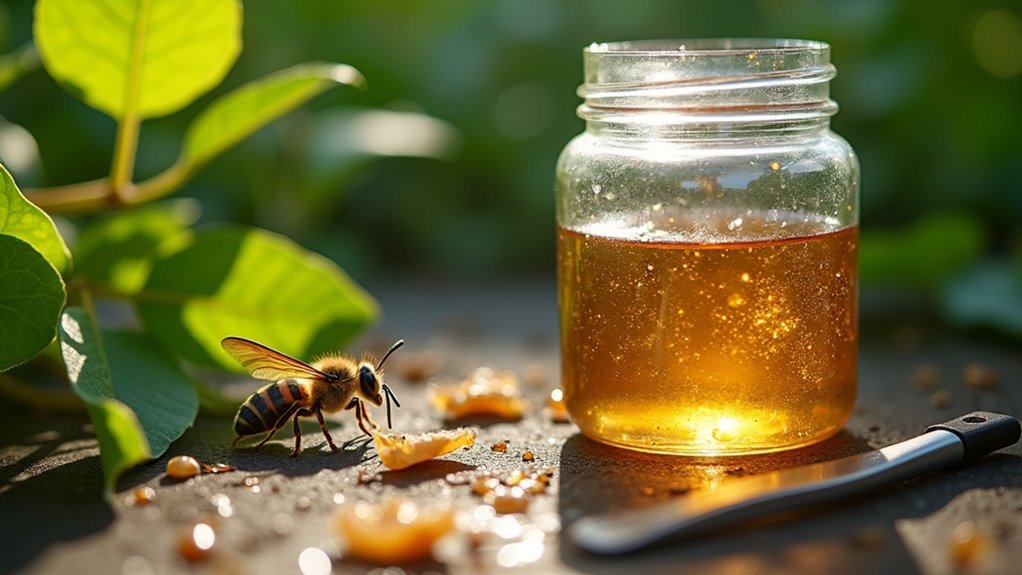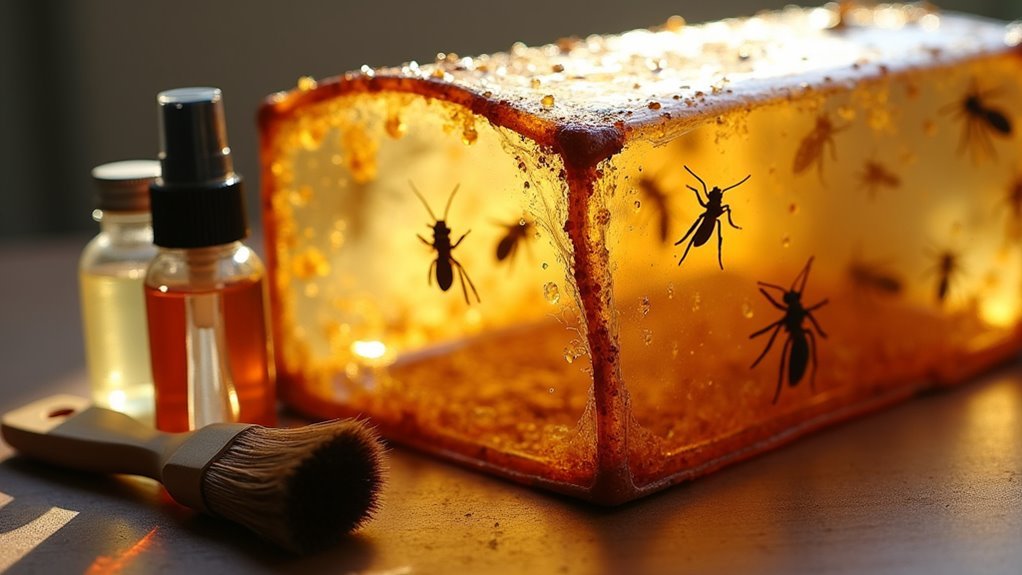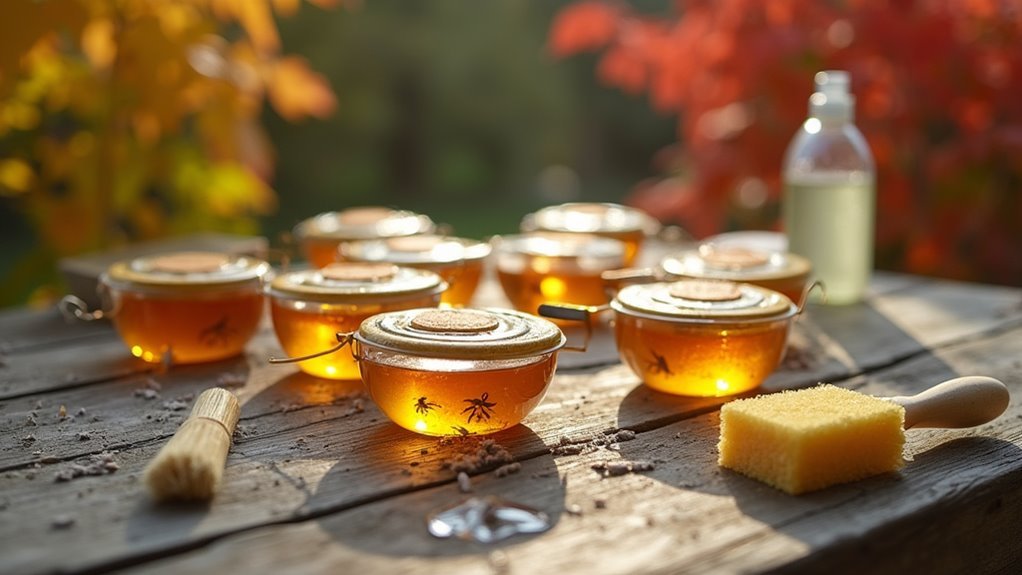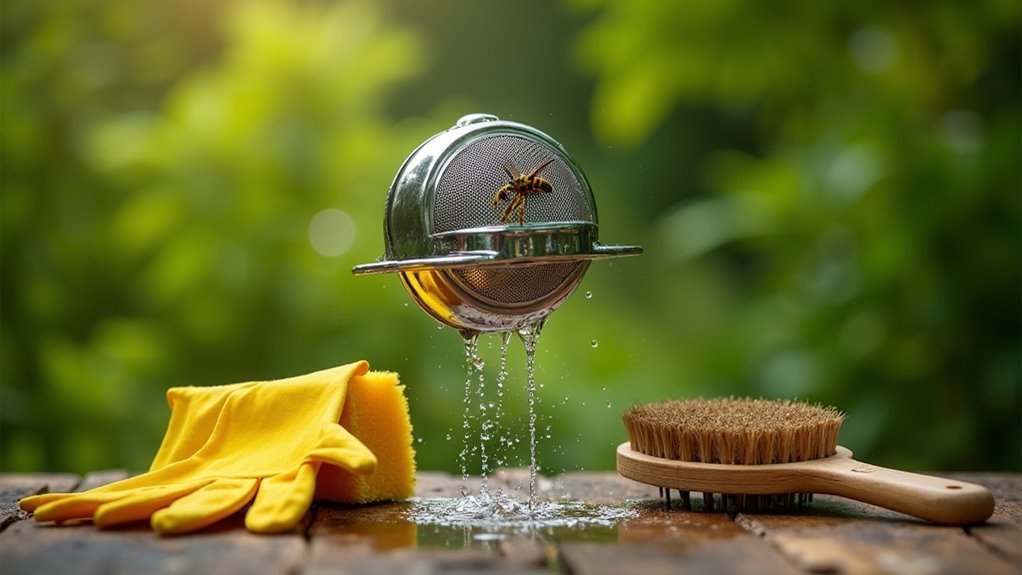You’ll maximize your hornet trap’s effectiveness by emptying them every few days, cleaning with warm soapy water and vinegar, then disinfecting with a 1:10 bleach solution. Remove debris blocking entry points, rinse thoroughly, and air dry completely before repositioning traps near food sources or nesting areas. Inspect for damage after storms, rotate locations every 3-4 days, and maintain a bi-weekly cleaning schedule during peak season. These proven strategies will reveal advanced techniques for peak performance.
Regular Emptying and Debris Removal Techniques

While hornet traps provide excellent pest control, they’ll only remain effective if you maintain them properly through regular cleaning.
Regular emptying every few days prevents overflow that can attract other pests and maintains prime trapping efficiency. When cleaning out traps, inspect for debris like leaves or dirt that obstruct entry points and reduce effectiveness.
Empty traps every few days and clear debris from entry points to maintain optimal hornet trapping efficiency.
Always wear protective gloves during maintenance to avoid potential stings from surviving hornets.
Use water and dish soap to thoroughly clean traps, removing residual attractants and dead insects that compromise performance.
After cleaning, dispose of contents far from your home to prevent attracting more hornets to the area.
This systematic debris removal guarantees your effective traps continue operating at peak performance throughout the season.
Proper Cleaning Solutions for Trap Sanitization
Three essential cleaning solutions will keep your hornet traps sanitized and functioning at peak performance.
Start with warm soapy water mixed with vinegar to eliminate residue and odors that attract hornets. This combination guarantees thorough trap sanitization without damaging reusable components.
After scrubbing, rinse thoroughly with clean water to remove all cleaning agents. Next, disinfect your traps using a diluted bleach solution—mix one part bleach with ten parts water to kill lingering bacteria effectively.
- Use warm soapy water and vinegar for initial cleaning
- Rinse completely with clean water after scrubbing
- Disinfect with 1:10 bleach solution ratio
- Air dry completely in well-ventilated areas
- Clean every two weeks during peak hornet season
Allow traps to air dry completely before refilling to maintain maximum trap effectiveness.
Eliminating Odors and Residue Buildup

Since sticky residues and lingering odors can compromise your trap’s effectiveness, you’ll need to tackle these issues with targeted cleaning methods.
Start by cleaning your hornet traps with warm soapy water mixed with vinegar, which breaks down residue buildup while neutralizes odors effectively. After cleaning, rinse thoroughly to remove soap and vinegar traces that might attract more hornets.
Clean hornet traps with warm soapy water and vinegar to break down residue and neutralize odors effectively.
Let traps dry completely before refilling to prevent moisture accumulation that creates unpleasant smells and promotes mold growth. For stubborn odor elimination, soak traps in baking soda solution to absorb persistent scents.
Store your cleaned traps in a well-ventilated area during off-seasons to maintain freshness and prevent moisture buildup between uses.
Strategic Trap Repositioning for Optimal Performance
Because hornets quickly adapt to static threats, repositioning your traps every few days maintains their effectiveness and prevents these intelligent insects from developing avoidance patterns.
Strategic trap repositioning requires careful consideration of environmental factors and hornet behavior to achieve peak effectiveness.
Position your traps in shaded areas to prevent bait spoilage and attract hornets during peak activity hours. You’ll want to elevate traps by hanging them from trees or structures, reducing non-target species interference while increasing visibility.
Monitor trap locations continuously, moving them closer to food sources like dining areas or garbage bins.
Key repositioning strategies include:
- Place traps near known food sources for maximum attraction
- Elevate traps off ground level to minimize unwanted catches
- Move traps closer to nesting sites when activity concentrations appear
- Rotate between shaded locations every 3-4 days
- Adjust positioning based on observed hornet traffic patterns
Seasonal Maintenance Schedule Planning

While strategic repositioning keeps your traps effective throughout active periods, developing an extensive seasonal maintenance schedule guarantees consistent performance across entire seasons.
You’ll need to inspect and clean your hornet traps every two weeks during peak activity months for peak trapping efficiency. After heavy rain or storms, check trap locations immediately to remove accumulated water and debris.
Monitor trap performance throughout the season, adjusting positions based on hornet activity patterns. At season’s end, thoroughly clean traps with soap and water to prevent mold and bacteria growth before storage.
Regular monitoring and position adjustments maximize trap effectiveness, while proper end-of-season cleaning ensures equipment longevity and prevents contamination.
Document captures and necessary adjustments during each cleaning session. This data improves future trap placement and refines your bait strategies, ensuring maximum effectiveness year after year.
Bait Replacement and Refreshing Methods
Though seasonal maintenance provides the foundation for trap success, effective bait replacement and revitalizing methods guarantee your hornets remain consistently attracted to your traps.
You’ll need to replace bait every 1-2 weeks to maintain effectiveness as scent appeal diminishes over time.
Your bait replacement strategy should adapt seasonally:
- Use protein-based bait (tuna, cat food) during spring and early summer
- Switch to sugar-based bait (soda, fruit juice) in late summer and fall
- Clean traps thoroughly with warm soapy water before refilling
- Position traps away from areas frequented by beneficial bees
- Check traps regularly for fullness and lost appeal
These revitalizing methods guarantee your control efforts remain efficient.
Always remove residues when cleaning traps, as they can deter hornets from entering and compromise your hornet traps’ performance.
Equipment Inspection and Damage Assessment
Beyond maintaining fresh bait, your traps themselves require regular equipment inspection to guarantee they’re functioning at peak performance.
During damage assessment of your hornet traps, check for cracks or holes that could allow escapes. Verify bait compartments remain intact and functional, as damaged sections lead to ineffective trapping.
Damaged trap components compromise containment effectiveness, allowing hornets to escape and reducing your pest control success rates significantly.
Clear any blockages from entry points while confirming they prevent escape routes. Evaluate the overall structure for stability, confirming it withstands outdoor elements without tipping.
Document all issues discovered during inspections for effective performance tracking over time. This documentation helps you determine when replacements or repairs become necessary, maintaining your trap’s effectiveness against hornet populations and protecting your property investment.
Frequently Asked Questions
What Is the Best Liquid to Put in a Wasp Trap?
You’ll want to use a mixture of 3/4 cup white vinegar, 2 tablespoons sugar, and 1 teaspoon salt. This combination effectively attracts wasps while avoiding ingredients that’ll lure beneficial bees into your trap.
How Do You Remove Hornet Nest Residue?
You’ll need protective gear, then scrub the papery residue with soapy water. Dispose of debris in sealed bags, clean with disinfectant to remove scent markers, and work during evening hours when hornets aren’t active.
Does Soapy Water Work on Hornets?
Yes, soapy water works on hornets by clogging their breathing holes and suffocating them. You’ll need about two tablespoons of dish soap per quart of water for effectiveness against individual hornets.
Do Hornets Dislike Vinegar?
You’ll find hornets are deterred by vinegar’s strong scent, making it useful for repelling them. However, it’s not foolproof and can provoke them if used incorrectly, so combine it with other methods.
In Summary
You’ll maximize your hornet trap’s effectiveness by implementing these seven cleaning strategies consistently. Don’t skip regular emptying or proper sanitization—they’re essential for maintaining peak performance. Remember to reposition traps strategically and follow seasonal maintenance schedules. Fresh bait and thorough equipment inspections can’t be overlooked. When you stay proactive with cleaning and maintenance, you’ll guarantee your traps continue protecting your property from aggressive hornets throughout the entire season.





Leave a Reply